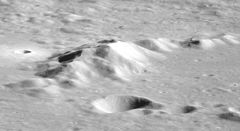Keeler (lunar crater)
 Lunar Orbiter 2 image | |
| Coordinates | 10°12′S 161°54′E / 10.2°S 161.9°E |
|---|---|
| Diameter | 160 km |
| Depth | 3.0 km[1] |
| Colongitude | 200° at sunrise |
| Eponym | James E. Keeler |
Keeler is a large lunar impact crater that lies on the Moon's far side. It is connected along the eastern edge to Heaviside, a walled plain of similar dimensions. Keeler, however, is the younger of the two formations, with more clearly delineated features. To the northeast of Keeler is the smaller crater Stratton, and to the northwest lies Ventris.

The outer rim of Keeler is roughly circular, with a straight segment where it is joined to Heaviside. The northern portion of the rim is more irregular, with an outward protuberance to the north-northwest. Portions of the inner wall have a terrace structure, especially along the southern half. Note the terraced walls of the crater. Within the crater interior, Planté lies on the eastern floor, adjacent to the inner wall. There is an interior ridge that runs from about the midpoint toward the west-southwest. The floor is generally level, with some areas of irregularity to the south. A few small craters mark the interior plain.
Measurements with the electron reflectometer instrument on board the Lunar Prospector showed that this crater is one of a number of impact sites that show demagnetization. The low magnetic reading lies at the center of this crater, and the reduced field extends outward to about one and a half crater diameters. Scientists believe that shock demagnetization is the cause.[2]
Keeler is one of the largest craters of Lower (Early) Imbrian age.[3]
The crater was named after American astronomer James Edward Keeler by the IAU in 1970.[4] Keeler was known as Crater 302 prior to naming.[5][6] A highly eroded crater that is west of Keeler and somewhat larger than it was designated Crater 300, but it is currently unnamed.
Satellite craters


By convention these features are identified on lunar maps by placing the letter on the side of the crater midpoint that is closest to Keeler.
| Keeler | Latitude | Longitude | Diameter |
|---|---|---|---|
| L | 13.3° S | 163.2° E | 71 km |
| S | 11.4° S | 158.0° E | 30 km |
| U | 9.1° S | 156.9° E | 29 km |
| V | 8.9° S | 158.3° E | 53 km |
- Keeler S crater photographed by Apollo 8
References
- ^ LTO-85C1 Plante — L&PI topographic orthophotomap
- ^ Halekas, J. S.; Mitchell, D. L.; Lin, R. P.; Frey, S.; Hood, L. L.; Acuna, M. H.; Binder, A. B. (May 2001). "Demagnetization Signatures of Lunar Impact Craters" (PDF). American Geophysical Union, Spring Meeting 2001, abstract #GP22A-11. Bibcode:2001AGUSM..GP22A11H. Retrieved 2010-01-28.
- ^ The geologic history of the Moon. USGS Professional Paper 1348. By Don E. Wilhelms, John F. McCauley, and Newell J. Trask. U.S. Government Printing Office, Washington: 1987. Table 10.2.
- ^ Keeler, Gazetteer of Planetary Nomenclature, International Astronomical Union (IAU) Working Group for Planetary System Nomenclature (WGPSN)
- ^ Lunar Farside Chart (LFC-1A)
- ^ Lunar Landmark Locations - Apollo 8, 10, 11, and 12 Missions. NASA technical note D-6082. Manned Spacecraft Center, Houston, Texas. November 1970. Figure 4.
Other sources
- Andersson, L. E.; Whitaker, E. A. (1982). NASA Catalogue of Lunar Nomenclature. NASA RP-1097.
- Blue, Jennifer (July 25, 2007). "Gazetteer of Planetary Nomenclature". USGS. Retrieved 2007-08-05.
- Bussey, B.; Spudis, P. (2004). The Clementine Atlas of the Moon. New York: Cambridge University Press. ISBN 978-0-521-81528-4.
- Cocks, Elijah E.; Cocks, Josiah C. (1995). Who's Who on the Moon: A Biographical Dictionary of Lunar Nomenclature. Tudor Publishers. ISBN 978-0-936389-27-1.
- McDowell, Jonathan (July 15, 2007). "Lunar Nomenclature". Jonathan's Space Report. Retrieved 2007-10-24.
- Menzel, D. H.; Minnaert, M.; Levin, B.; Dollfus, A.; Bell, B. (1971). "Report on Lunar Nomenclature by the Working Group of Commission 17 of the IAU". Space Science Reviews. 12 (2): 136–186. Bibcode:1971SSRv...12..136M. doi:10.1007/BF00171763. S2CID 122125855.
- Moore, Patrick (2001). On the Moon. Sterling Publishing Co. ISBN 978-0-304-35469-6.
- Price, Fred W. (1988). The Moon Observer's Handbook. Cambridge University Press. ISBN 978-0-521-33500-3.
- Rükl, Antonín (1990). Atlas of the Moon. Kalmbach Books. ISBN 978-0-913135-17-4.
- Webb, Rev. T. W. (1962). Celestial Objects for Common Telescopes (6th revised ed.). Dover. ISBN 978-0-486-20917-3.
- Whitaker, Ewen A. (1999). Mapping and Naming the Moon. Cambridge University Press. ISBN 978-0-521-62248-6.
- Wlasuk, Peter T. (2000). Observing the Moon. Springer. ISBN 978-1-85233-193-1.

